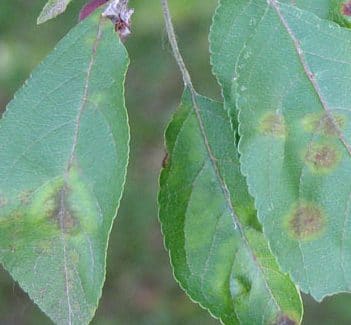As one of our fair presidents, Franklin D. Roosevelt, once said, “Forests are the lungs of our land, purifying the air and giving fresh strength to our people.” We are blessed to have a climate that sustains the growth of a variety of beautiful trees. However, our weather also lends itself to an assortment of damaging fungal diseases that can harm the splendor and vivaciousness of our cherished wooded friends. As with many pests the best action is to be proactive. To help you know what to look for, here is a brief overview of some of the most common and damaging tree diseases.
Crab-Apple Scab
Apple Scab is the most common disease that attacks apple and crab-apple trees. Unfortunately it thrives in the mild temperatures of our spring and summer weather.
The fungus will appear as small brown spots on the underside of the leaves of the tree and will eventually spread to the top of the leaves and finally, the fruit itself. The brown spots on the fruit feel rough to the touch, similar to a scab. The fruit, although in most cases edible, is often malformed, cracked and will drop prematurely. A severe Apple Scab infestation can lead to the tree to becoming completely defoliated.
Anthracnose
Anthracnose, sometimes referred to as leaf blight, is a disease that attacks some of our favorite hardwood trees including ash, sycamore, dogwood and oak. It is caused by a number of different related fungi each affecting a different variety of host tree. Infected trees will have dark, wet-looking spots on their leaves, stems and even fruit. As the disease progresses the leaves of the tree will increasingly become brown or black and fall prematurely. Although the disease itself only causes minimal damage to the tree, the resulting repeated defoliation will leave it weak and susceptible to attacks from other diseases and more damaging pests.
Needle Cast
Our beloved evergreens are not safe from disease either. Needle cast is a group of fungal diseases that cause conifers to shed their needles. The needles of an infected tree turn from yellow to red and finally brown and will eventually drop. Unfortunately, shedding needles is more dangerous to conifers than the premature falling of leaves to hardwoods. The outcome is a tree dangerously weakened because of its reduced ability to undertake the process of photosynthesis.
Our certified arborists have the knowledgeable know-how to help your trees remain free of disease, or return them to their balanced state of health. If you have further questions regarding signs or symptoms of tree disease feel free to leave it to us. You can each us at 717-564-1995 to learn more.


